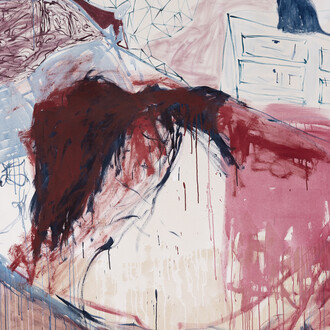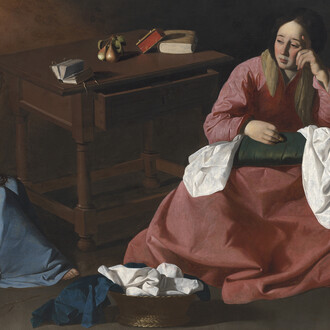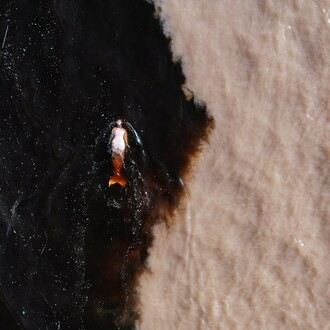Growth of the soil, a group exhibition at Kristin Hjellegjerde Gallery, is a love song to nature, to living slowly, peaceably and generously, in harmony with the seasons and elements. Titled after Knut Hamsun’s novel about a man building a homestead in rural Norway, the show invites artists to reflect on sustainability, simplicity and our relationship to the land. Drawing on folklore, fantasy, ecology, myth and map-making, these works open a space to imagine how we might live differently, more attuned to the earth’s rhythms.
Bunmi Agusto’s work centers around a fantasy world called ‘Within’, a space through which she explores psychology, cultural theory, spirituality and selfhood. Her painting Planting the hybrids shows the braided hands of Ó, a deity in this realm, enacting a divine creation that reflects how inner life, like nature, unfolds through cycles of planting, gestation, and transformation. Marie-Anita Gaube similarly employs hybrid figures and surreal compositions to probe the idea of heterotopias – spaces where the boundaries of body and landscape blur, and rituals unfold in dreamlike communion with the earth.
This intermingling of the real and the imagined is echoed in Slimen Elkamel’s kaleidoscopic paintings, where memory, emotion and natural forms fuse into dynamic, living surfaces. The works pulse with colour and sensation, conveying not just the ecological urgency of our reconnection with nature, but also the emotional and spiritual richness such a renewal might offer. Atalanta Xanthe’s depiction of a naked woman riding on a pig also hints at a more ancient, intuitive relationship with the natural world. The pig leads; the woman is simply carried, her posture and expression suggesting a quiet resignation, yielding to the unknown, evoking a moment of surrender that is both unsettling and vulnerable.
Lotte Keijzer, by contrast, reflects on how we misread and project onto nature through the filter of domestic ideals. In The idealised paragon, a staircase lined with green swan-patterned wallpaper evokes the rituals and aesthetics of bourgeois life. Swans are often seen as symbols of monogamy and purity. In reality, they are neither strictly monogamous nor heterosexual, reminding us that nature, like human identity, resists tidy categorisation. Grgur Akrap uses layered wax and pigment to explore the tension between the visible and invisible, evoking the symbolic depth of our relationship with the natural world. His enigmatic scenes – a tiger clinging to a boy, a naked man walking beside a cheetah – suggest a world where humans and animals are bound by instinct, myth and perception.
Serena Caulfield mines fairy tales, childhood books and aural storytelling to build vivid ‘mashup allegories’ that explore the persistence of early memories. Like Akrap and Gaube, she looks to nature as a site of imaginative return: an environment where personal history and collective myth can merge. Maciej Kość also draws on the language of folklore. In Belshazzar’s feast, two birds – one carrying a golden egg, the other glowing with one inside its throat – act as surrogates for the artist, seeking fleeting moments of beauty, drama or revelation. The egg becomes a symbol of emotional insight, illuminating the fragile, instinctive relationship between inner life and the natural world.
Nelleke Cloosterman’s paintings invite us into a mysterious space that feels both ancient and contemporary. The natural world emerges as ghostly impressions lurking in the gloaming, flickering in and out of visibility – present, yet always just out of reach. This elusive quality resonates with Alexander Appleby’s work, where flora becomes a metaphor for the complexities of family dynamics and control. While his six-headed daffodil symbolises a nurturing support system, with multiple blossoms growing from one stem, his bonsai tree evokes tension between care and constraint.
Santiago Giralda's landscapes are explosions of colour and movement. In his densely detailed works, nature appears not just alive, but expanding. Of his works he says, 'the earth is neither a backdrop nor a resource: it is an active presence, demanding attention, work and respect . 'They invite us to succumb to the experience of simply being, allowing the painting to unfold around us. A map by the sami artist Hans Ragnar Mathisen, meanwhile, depicts the world as seen by his people. Hand- drawn in pencil and ink, and incorporating animals, plants, ancient sami language and symbols, the work becomes both a real-world resource and an imagining of an alternative worldview.
Emma Critchley's Sirens, a triptych of short films, immerses us in the deep ocean, exploring encounters between a dancer and three creatures from the depths as a poetic reflection on learning from radically different lifeforms. Lester Rodriguez's sculptural installation confronts this inquiry with urgent political reality, using data from the carbon majors report to materialise corporate emissions as carved wooden bars coated in latex-turning abstract figures into physical objects that call for accountability and action.
Together, the artists in Growth of the soil remind us that nature is not only what surrounds us: it is what forms us. These works resist binaries of real and imagined, human and nonhuman, physical and spiritual. They call us to a different kind of attention; one that is receptive rather than extractive, in which care, wonder and imagination become tools for resistance and repair.
















